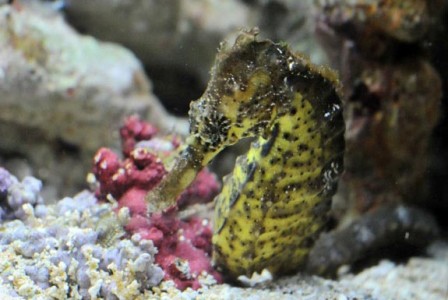Seahorses Give Birth in Aquarium Nursery
January 14th, 2009 | by Alice Keesing | Published in Features, Jan. 2009, Multimedia | 4 Comments

- Web extra:
 Seahorses Stampede at Waikīkī Aquarium
Seahorses Stampede at Waikīkī Aquarium
Aquarist Norton Chan has had his hands full when newborns arrive. First it was the bigfin squid. Then it was the seahorses.
In early August 2008, one of the male seahorses in the mini marine life tank in Gallery 3 at the University of Hawaiʻi’s Waikīkī Aquarium began to look like he was in a fatherly way.
The seahorse, one of the species of Hippocampus kuda found in local waters, was placed in a nursery tank behind the scenes, where he gave birth several days later to about 500 offspring—all perfectly formed seahorses about 4 millimeters tall. A second small herd was born in early September.
And while there is all this activity behind the scenes at the aquarium, seahorses in the wild also appear to be enjoying something of a resurgence.
Seeing a seahorse outside of an aquarium has been something of a rare experience. Now Chan hears reports of seahorse spottings from ankle-deep water at a popular beach to harbors and piers. (Sorry, the aquarium keeps precise locations quiet lest collectors deplete populations once more.)
Sudden resurgence in a species often occurs thanks to a fluke of good conditions. If a high number of juveniles survive in one breeding season, the population can quickly build on itself. The phenomenon was recently been witnessed in the bigfin squid.
Waikʻkʻ Aquarium has long worked on breeding and raising seahorses. Understanding the life cycle of the rare Hawaiian seahorse will help scientists unravel some mysteries, such as whether its presence over very deep water and in the stomachs of tuna mean it is pelagic, or an open ocean fish.
And yes, it is a fish—with a backbone, gills for breathing and scales that have fused together into an armor-like casing. Its tail curls so it can grasp onto plants, corals or rocks. The long tubular jaw is used like a pipette to suck up tiny drifting plankton.
Evem more unusual is the animal’s fascinating breeding habits.
The process begins with daily bonding activities as seahorse couples swim together each morning with their tails entwined. When it is time to mate, the female deposits her eggs into a brood pouch on the male’s belly, where they are fertilized.
The father carries the embryos as they develop into miniature versions of the adults. His labor can last up to a day and a half.
The young emerge as fully formed—and hungry—seahorses. Because they have no teeth or true stomach, food passes through their digestive tract very quickly, making them voracious eaters. Chan started the new herd on copepods and newly hatched brine shrimp.
The knowledge scientists gain while raising these seahorses can ultimately help protect these animals in the wild. Around the world, many species of seahorses are threatened by overfishing.
They are in high demand for medicinal purposes in Asia. Many more are sold as souvenirs. The endearing fish are also popular aquarium pets, and the recent population peak in Hawaiʻi has resulted in an influx of wild-caught seahorses into the pet stores.
Chan discourages keeping a seahorse as a pet. Wild-caught seahorses prefer live food, which can be very difficult to obtain, so these animals often come to an unfortunate and quick end.
Aquacultured or tank-raised juveniles that are accustomed to frozen foods can be hardier, he says.
Seahorse Stats
- Name: Hippocampus kuda, smooth seahorse
- Color: Ranges from yellow to orange to black
- Length: Averages 11–13 centimeters
- Life span: Can be more than 2 years in captivity
- Diet: Crustacean plankton
- Sexual maturity: 4–12 months
- Gestation: 9–10 days at warmer temperatures
Reprinted from Waikīkī Aquarium’s Kilo iʻa newsletter
Web extra: Seahorses Stampede Waikīkī Aquarium
Tags: Jan09 issue, marine biology, UH Manoa, Waikiki Aquarium

January 16th, 2009at 10:27 am(#)
WOW! I didn’t realize that seahorses could be found in local waters. In fact, I just told my nephew that, and am glad to be corrected. Am sending him this link. Keep up the good work. I am definitly a fan.
Jo
January 16th, 2009at 3:33 pm(#)
WOW! is an apt description of the seahorses. We lived just a few blocks away the Aquarium from 1975 – 1981, my mother was a docent there, our children spent many happy hours there as well,and it was a favorite site for our of town visitors. What a great gift it is too all of us.
January 20th, 2009at 10:43 am(#)
How wonderful! Congratulations to Norton and his crew as well as to malamalama for bringing this to our attention,
Petra
April 5th, 2011at 6:46 am(#)
Thank you for sharing this educational and inspiring video with all of us. I am very glad to “virtually” meet those responsible for this aquarium and particularly the raising of sea horses! I will always be a fan and will visit often :)